So how many times have I said on this blog, "Nature does not play by rules"? It is my way of saying, "expect the unexpected" while outdoors to protect yourself. Well, here is a situation where I had a hard time following my own advice. Admittedly, this was not one of my better moments, and I probably could have reacted better.
A few hours after I encountered those river otters (A few blog entries back) I went on another short walk right before noon. I remember thinking how I was going to edit that otter video for YouTube while I was walking. Then I was thinking of how I could link it to another wild animal video I did. Then coincidentally, like a gift from heaven, the other wild animal showed up in my view.
Quick disclaimer: there are some "quick word graphics" in this video. Not really quick flashing, and imo rather mild to other things on Youtube, but if you sensitive to that sort of thing then you should know.
As it got closer and closer to me I was thinking, "Seriously? Seriously? It does see me right? Am I going to have to defend myself or run away?" Looking back I probably should have said something or made some sort of noise. When it got just a few feet away I started moving away, and that is when it realized I was a real person. It jumped up, and did a 180 degree turn, ran away, and climbed that tree.
I was pretty sure it was a harmless young bear that probably had just left his mother a few months earlier, but the one bear you have to avoid for black bears is the "stalking bear" (predatory bear). Keep in mind that there was not any trail or reason it should have come directly at me like that. That is what freaked me out at the time. As I said in the video, I think it just caught my scent and decided to head toward it. Then when it realized I was a living person its youngster instincts kicked in which made it climb the tree.
As I said in the video, I was kind of sad that I turned the camcorder off when it ran back and climbed the tree. It was really cool to see that. After it left I kept my distance and tried to walk a nearby road to see if I could see it again, but it was gone. I could have followed it better than I did by going directly where it went, but after our little encounter I did not want to spook it anymore than I had already had done.
If you hadn't seen the blog(s) I did on my black bear encounter two years ago then go there:
Investigating Ursus (Part 1)
Investigating Ursus (Part 2)
The music from Incompetech used in the video is called "Aggressor".
Here I explore the artwork that has been done in nature. This usually consists of my "hiking adventures", movie locations, or just some unique place that is a little out of the ordinary.
Saturday, August 26, 2017
Saturday, August 12, 2017
Ancient Sentinels (Bristlecone Pine Forest, White Mountains)
(GPS: N37 23.140 W118 10.720)
As one goes north on the 395 HWY and passes the town of Big Pine there is a big sign on the right side of the road the says, "Ancient Bristlecone Pine Forest". To get there you have to take the 168 HWY towards the east and then up the White Mountains to reach this area. I remember countless times seeing that sign every time I went by there wondering what that place was about. It was probably back in the early 2000's that I made my first trip here. I went back there a few years ago for some better pictures and video of the place.
This is the blog that I have been somewhat hesitant in doing. I've mentioned this place before in this blog at some point, and I've always wanted to say something about it, but how I wanted to do that was the issue. It is not an Eastern Sierra location, but it is close enough in the White Mountains further on the other side of the 395 HWY to the east. At the same time it is much more of a high desert mountain location with trees on it. In some ways, it is not as scenic looking as some of the other Eastern Sierra spots I have shown. The times I have been there it was very dry with no streams as one would have to expect.
The key is knowing what exists here, and that is what is important. But, how do I present it? Off and on I have struggled with this over the past year. Do I go purely educational on this one? Well, if I did that then I would make a long 30 minute boring video trying to explain everything. The place is well known enough that I suspect other people have done something like that and made it more interesting. Okay, so how about I go more suspenseful and entertaining for this one? You know, have some creepy music play as I show where we can be druids and live in harmony with these ancient living creatures that exist here. There was some thought of doing something like that and putting it out on Halloween or on New Year's Eve. After examining my video clips and pictures I thought that really wouldn't work. I would have to do a lot of editing to create some mystical look the place really hasn't had while I have been there. What happened on this one was I was in somewhat of a depressed mood, and I just told myself, "Let's do this one now and see what happens". I just started editing the clips together with some music, going over some of the booklets I have of this area, and putting it together. So the video ends up being a "bare minimum" educational video where I put together a few facts here and there. There are a few interesting scenic moments, and it helped that some clouds where hanging around in the distance to get some of that mystical feeling moments that music helps with.
Let's get to it...
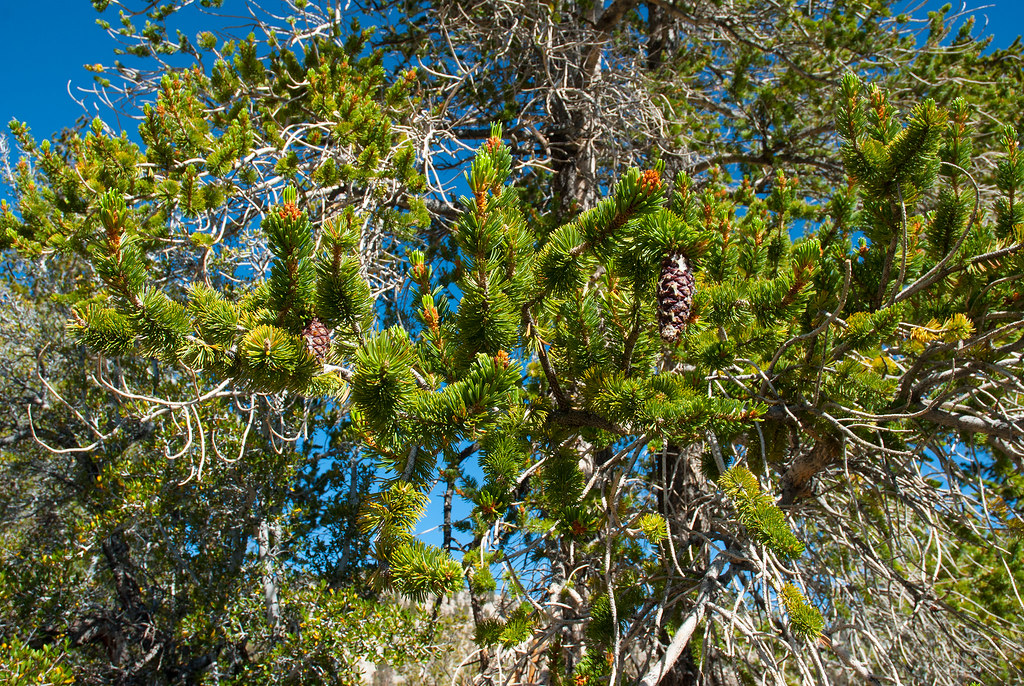
This is a close up of the bristlecones you can see on one of these trees. You should be able to see the bristles and the pinecones. One sees a lot of trees very much like this in the Eastern Sierra, but in this area one can find trees that have lived for thousands of years. The Ancient Bristlecone Forest ends up being the oldest known forest on the planet.
There are a few different groves to visit. A different one I have not been to is higher up on that takes more driving time to get to. This blog will deal with the popular Methuselah Grove that starts out at Schulman Grove Visitor Center. Edmund Schulman was the one who spent many years in the 1950's trying to determine the oldest trees by doing tests here.
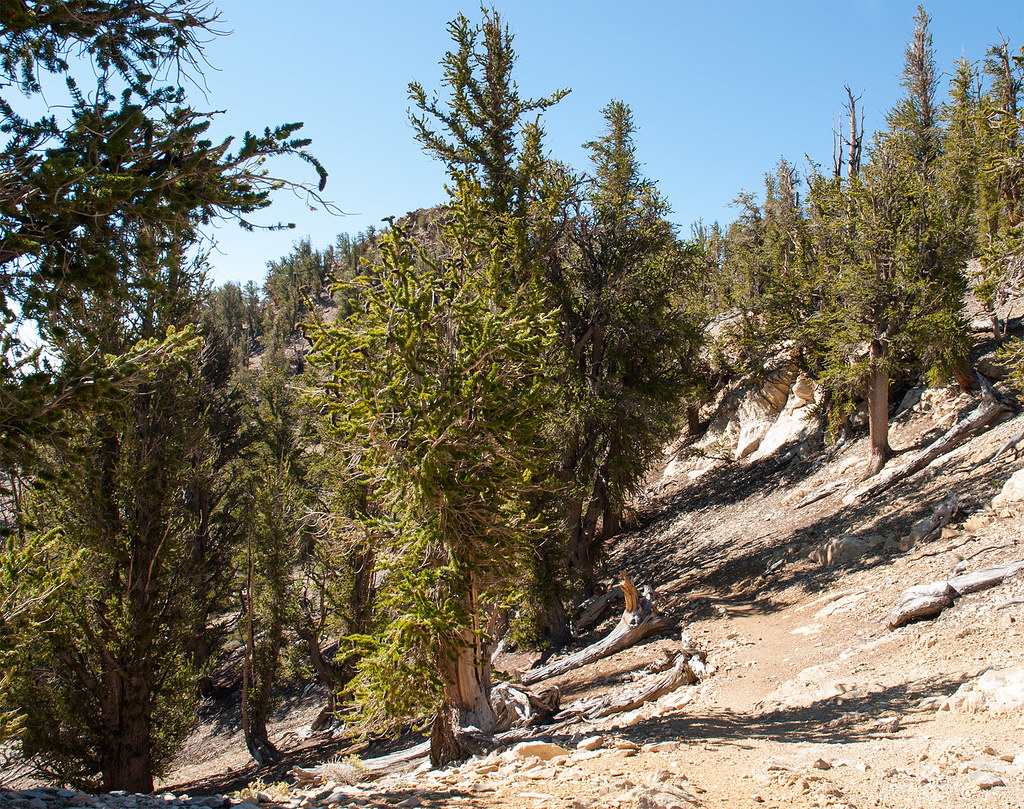
After depositing the fees necessary when I parked there I started the trail. The picture above is kind of typical of how the hike is. You pass by a bunch of trees like this with an occasional sign number which means you need to get out the little booklet that have for you to read what it says about the location. I based the video on the most recent booklet for some of the facts in the video. I also have the much older booklet which is a lot different in presentation.

The trails starts out at roughly 10,000 feet. You end up go up and down for an 800 foot elevation change over almost five miles. The hike is not difficult at all, but you are in an isolated spot with no water around. It is a good trail, but one should always be careful of not making any slips because you can start tumbling down the side of the mountain. Of course, a backpack with liquids should be with you during any hike like this. It really is a dry place not too far away from desert areas of Nevada and Death Valley.
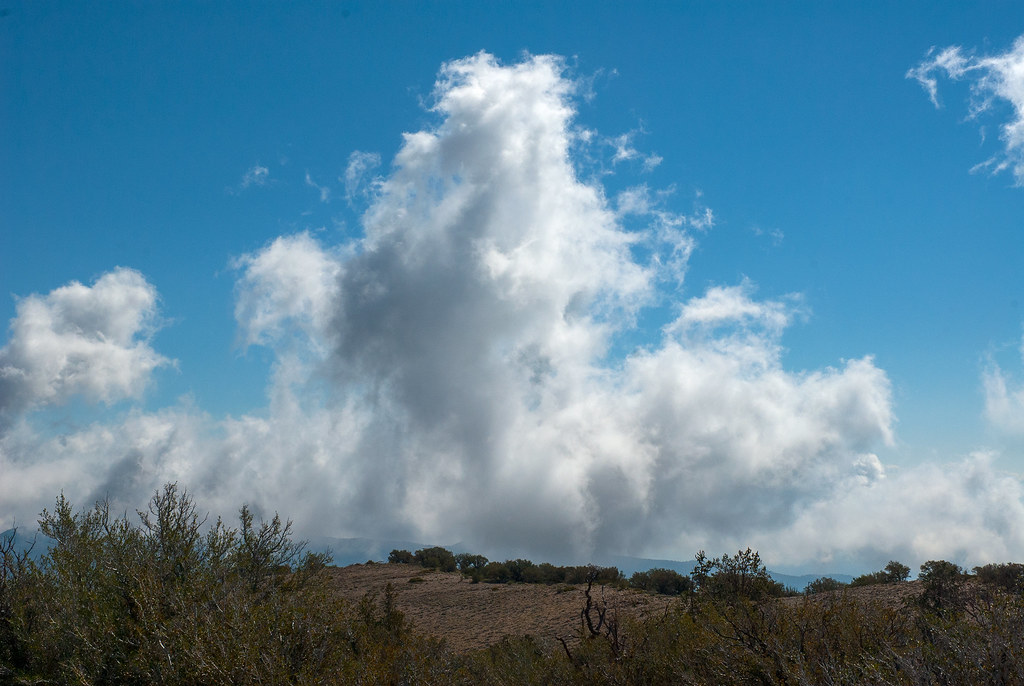
This time around was quite interesting because of the clouds being at this elevation. They did not feel like they were that far way. There were some nice scenic moments with them as I traveled around on this trail.
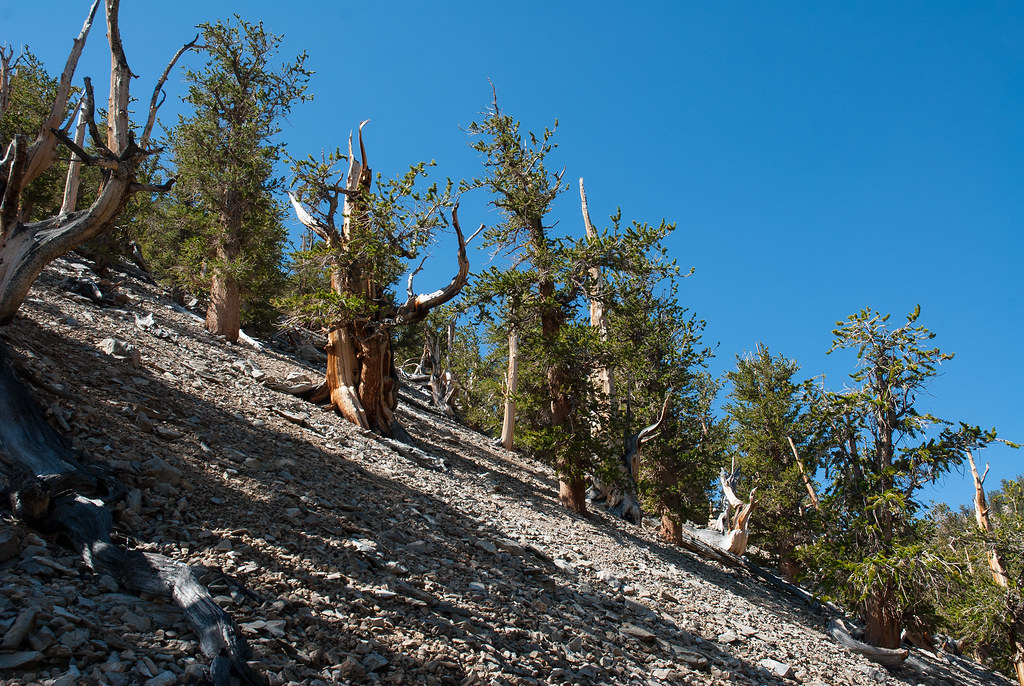
As I made my way around on this loop trail hike, about half way around I finally got to the Methuselah Grove part of the hike. This is where all the oldest trees are. Some of the trees up to this point are hundreds of years old, but once you get here some of these trees go back thousands of years.
A couple of things I should point out. It is weird that trees live up in this high altitude place in a desert mountain location. You will notice the trees above are living on dolemite rocky soil. Typically, dolemite soil would be something very difficult to grow on, but the advantage is other types of plants do not grow on it. Also, the dolemite reflects the sun keeping the area a few degrees cooler for the trees that live here. One other factor that helps some of these trees is growing on the northern side of the mountain. That gives them less sunlight, but more water and snow during the winter season.
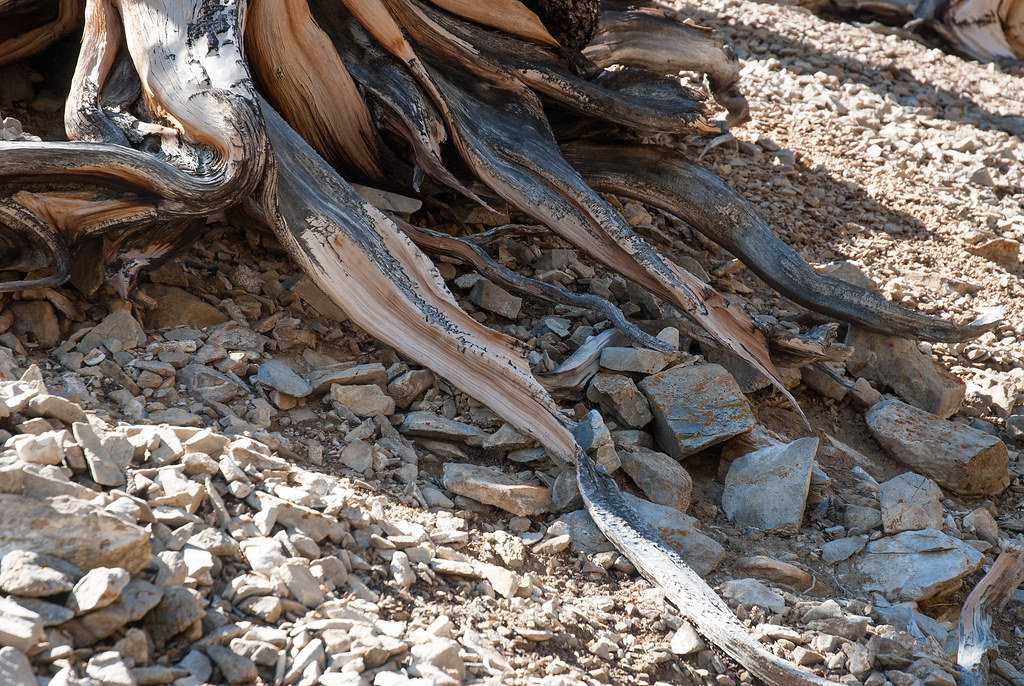
Another factor that helps these trees is that many of the roots and branches go just enough under the soil or grow parallel to it. This allows them to get any water that may not go very deep.
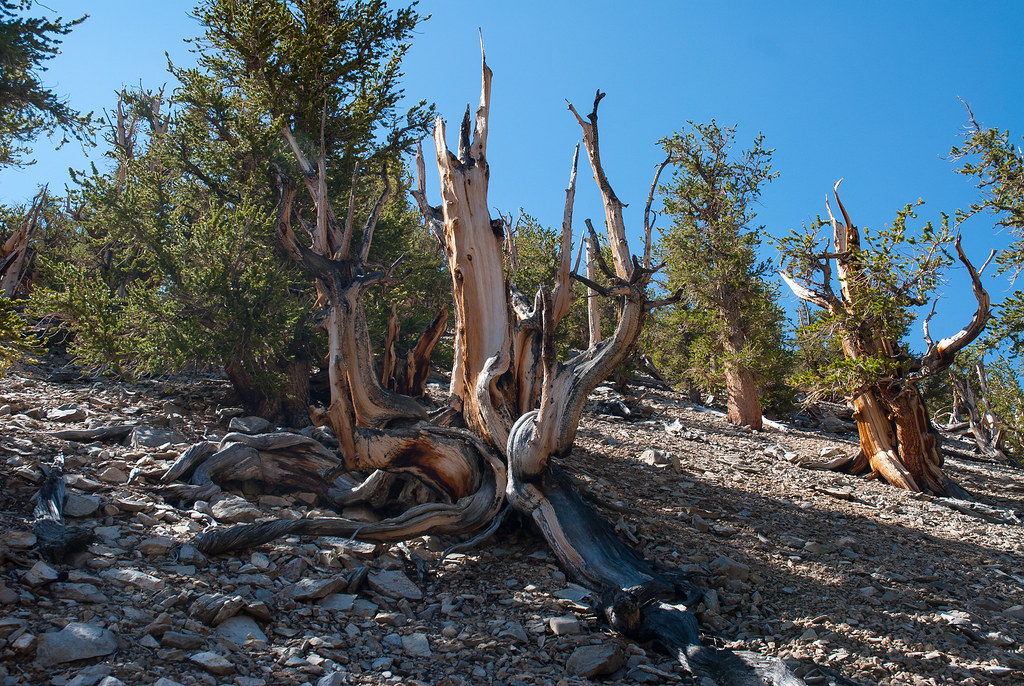
Some of the most interesting looking trees are the ones that have been sculpted by the environment over the centuries. I took a lot of pictures like this that you can see linked below on my Flickr account.
What happened is back in the 1950's Schulman found a tree in this grove that has been dated to roughly 4,700+ years of age. It is amazing to think there is a living thing here that dates back to before the birth of Christ, the Roman Empire, and Ancient Greece to basically when the earliest civilizations existed in Mesopotamia and Egypt. That tree is called "Methuselah" after oldest man written of in the Bible.
That is would I would have told you after my first trip, but it gets better. After many decades of referring to that tree as the oldest, in 2010 another tree here was dated over 5000+ years old making it the oldest tree here. Which gets a little strange because now you have an older tree than "Methuselah".
I guess I would say this is another area that I would summarize as "Survival of the Fittest". Where only the roughest trees have adapted to this area. They have the ability to live off limited resources, yet live so long. For that reason it is a very special place.
With all of that said, I am certainly not an expert on this place. Although I have a book I purchased many years back as well as the booklets about this place, a lot more could be said about it. If you are hardcore into trees like this then there is a lot of things you can find online about it. I'm just going to link a few things, but google is your friend on this one if you want more.
First, my YouTube video and other pictures I took on uploaded to Flickr:
Ancient Bristlecone Pine (White Mountains): all my pictures on Flickr are here.
A few links:
Ancient Bristlecone Pine Forest (Wikipedia): check the footnotes for this article.
An PDF Article about Edward Schulman
USDA site: how to get there, fees, etc.
The music used from Incopetech.com in the video is called, "Ever Mindful".
Sunday, August 06, 2017
A Former Luftwaffe Pilot (and Some Planes)
I was going to do this blog two weeks ago about the same time as the Dunkirk movie and the blog about that Spitfire, but decided to wait. Part of the reason was that movie really does not show any German humans in it. I think that is one of the movies strengths since you never see the face of the enemy in that movie. It turns it into a horror survival story against invisible enemies. On the other hand, a movie like the classic Battle of Britain (1969) gives a respectable look at the enemy side.
Some months back I was able to visit the Palm Springs Air Museum to hear the story of a former Luftwaffe pilot. Harald Bauer was a teenager when he flying for the Luftwaffe near the end of the war. He flew mostly Fw-190s and then He-162 jets. He was eventually shot down in a He-162 by a P-51 as the 8th Air Force was bombing the base he was at.

He survived the crash and was captured. Since his mother was living in Germany and was an American, he was classified as an American at the end of the world. Eventually he got involved in journalism and came to the U.S. Then during the Korean War he flew for the U.S., but not as a fighter pilot. He flew a Lockheed Constellation near Alaska (I think). He currently lives in Atascadero, CA.
The He-162 jet:

He explains further details of his life in the videos I'll link below. I was glad I got to see him in person and hear his story. As I've said before, we are nearing the end of the lives of those who participated in WW2 so if you have a chance to hear from one then do so. Where I am at WW2 pilots are rare, but even rarer are Luftwaffe pilots.

Another look at the He-162 at the Planes of Fame Air Museum in Chino, CA.
Not really related to Bauer's story, but since I am showing some German Luftwaffe planes I should probably mention BF 109E #3523:

Built in 1939, this was flown in the Battle of France and Battle of Britain as an E-1. Then it was upgraded to E-7 and sent to the eastern front. Wulf-Dietrich Widowitz flew it and was shot down during an escort mission by a hurricane. He made a perfect wheels up landing on the ice of frozen lake. The plane sank and was recovered in 2003. They intend to restore it at a later date.
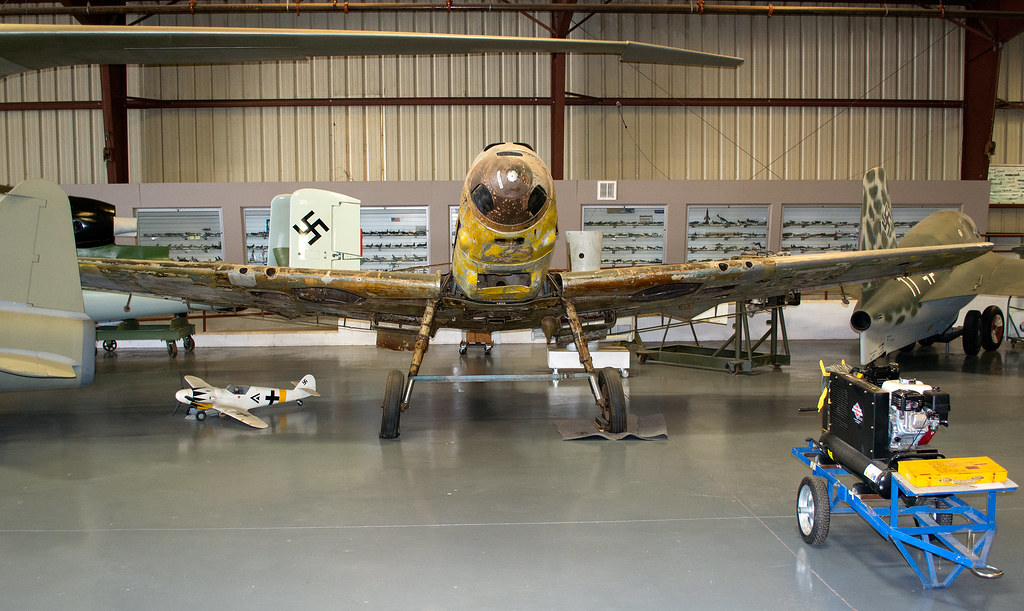
Click here for more pictures I have taken of some of these German Luftwaffe planes.
Other links:
To hear Harald Bauer's story go to this YouTube link: Heinkel He 162 Jet Fighter Test Pilot
The Flying Heritage site has a good interview of him as well: Commander Harald Bauer
An article on the Bf 109 #3523 and its recovery.
This will probably be the last of my blogs dealing with airplanes for while. There is something I probably do sometime next year, but it is time to get to nature in the next blog. Up next time will be the blog, video, and pictures that I have put off and off for the past year or so, but will finally get to. It is something that I have wanted to do, but how to present it is difficult. Well, let's see if I can do it.
Some months back I was able to visit the Palm Springs Air Museum to hear the story of a former Luftwaffe pilot. Harald Bauer was a teenager when he flying for the Luftwaffe near the end of the war. He flew mostly Fw-190s and then He-162 jets. He was eventually shot down in a He-162 by a P-51 as the 8th Air Force was bombing the base he was at.

He survived the crash and was captured. Since his mother was living in Germany and was an American, he was classified as an American at the end of the world. Eventually he got involved in journalism and came to the U.S. Then during the Korean War he flew for the U.S., but not as a fighter pilot. He flew a Lockheed Constellation near Alaska (I think). He currently lives in Atascadero, CA.
The He-162 jet:

He explains further details of his life in the videos I'll link below. I was glad I got to see him in person and hear his story. As I've said before, we are nearing the end of the lives of those who participated in WW2 so if you have a chance to hear from one then do so. Where I am at WW2 pilots are rare, but even rarer are Luftwaffe pilots.

Another look at the He-162 at the Planes of Fame Air Museum in Chino, CA.
Not really related to Bauer's story, but since I am showing some German Luftwaffe planes I should probably mention BF 109E #3523:

Built in 1939, this was flown in the Battle of France and Battle of Britain as an E-1. Then it was upgraded to E-7 and sent to the eastern front. Wulf-Dietrich Widowitz flew it and was shot down during an escort mission by a hurricane. He made a perfect wheels up landing on the ice of frozen lake. The plane sank and was recovered in 2003. They intend to restore it at a later date.

Click here for more pictures I have taken of some of these German Luftwaffe planes.
Other links:
To hear Harald Bauer's story go to this YouTube link: Heinkel He 162 Jet Fighter Test Pilot
The Flying Heritage site has a good interview of him as well: Commander Harald Bauer
An article on the Bf 109 #3523 and its recovery.
This will probably be the last of my blogs dealing with airplanes for while. There is something I probably do sometime next year, but it is time to get to nature in the next blog. Up next time will be the blog, video, and pictures that I have put off and off for the past year or so, but will finally get to. It is something that I have wanted to do, but how to present it is difficult. Well, let's see if I can do it.